The NVIDIA GeForce GTX 970 Review: Featuring EVGA
by Ryan Smith on September 26, 2014 10:00 AM ESTCompute
With GTX 980 NVIDIA surprised us with their stunning turnaround in in GPU compute performance, which saw them capable of reaching the top in many compute benchmarks they couldn’t before. GTX 970 meanwhile should benefit from these architectural and driver improvements, though since compute is nearly analogous to shader performance this is also a case where the performance difference between the GTX 970 and GTX 980 stands to be among its widest.
As always we’ll start with LuxMark2.0, the official benchmark of SmallLuxGPU 2.0. SmallLuxGPU is an OpenCL accelerated ray tracer that is part of the larger LuxRender suite. Ray tracing has become a stronghold for GPUs in recent years as ray tracing maps well to GPU pipelines, allowing artists to render scenes much more quickly than with CPUs alone

Thanks to GTX 980 taking the top spot here, GTX 970 still maintains a small lead over R9 290XU. So even with the GTX 970's weaker performance, it can still manage to outperform AMD's flagship in this case.
For our second set of compute benchmarks we have CompuBench 1.5, the successor to CLBenchmark. We’re not due for a benchmark suite refresh until the end of the year, however as CLBenchmark does not know what to make of GTX 980 and is rather old overall, we’ve upgraded to CompBench 1.5 for this review.
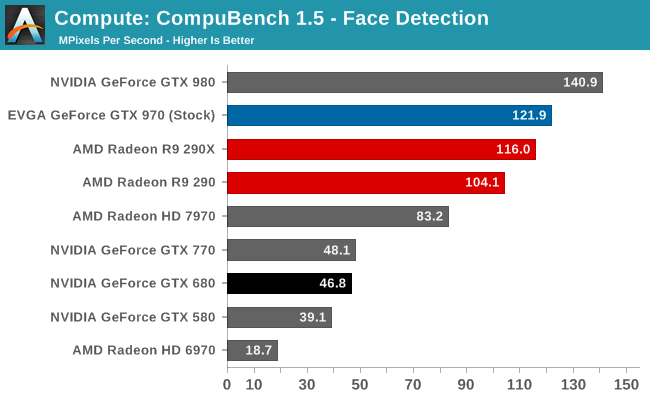
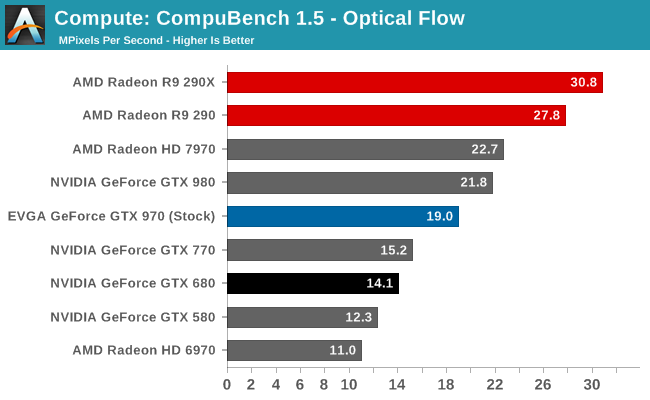
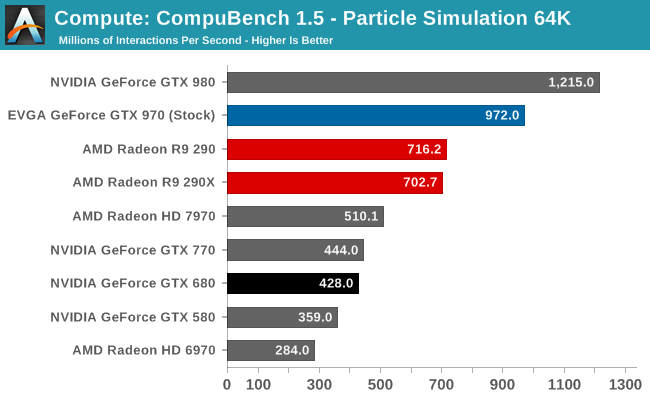
In the cases where the GTX 980 does well, so does the GTX 970. In the cases where the GTX 980 wasn’t fast enough to top the charts, the GTX 970 will be similarly close behind. Overall compared to AMD’s lineup we see the whole gamut, from a tie between the GTX 970 and R9 290XU to victories for either card.
Our 3rd compute benchmark is Sony Vegas Pro 12, an OpenGL and OpenCL video editing and authoring package. Vegas can use GPUs in a few different ways, the primary uses being to accelerate the video effects and compositing process itself, and in the video encoding step. With video encoding being increasingly offloaded to dedicated DSPs these days we’re focusing on the editing and compositing process, rendering to a low CPU overhead format (XDCAM EX). This specific test comes from Sony, and measures how long it takes to render a video.
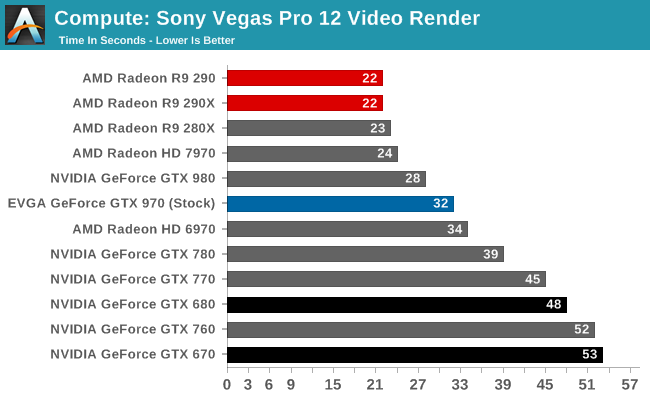
As expected, GTX 970 sheds a bit of performance here. AMD still holds a lead here overall, and against GTX 970 that lead is a little bit larger.
Moving on, our 4th compute benchmark is FAHBench, the official Folding @ Home benchmark. Folding @ Home is the popular Stanford-backed research and distributed computing initiative that has work distributed to millions of volunteer computers over the internet, each of which is responsible for a tiny slice of a protein folding simulation. FAHBench can test both single precision and double precision floating point performance, with single precision being the most useful metric for most consumer cards due to their low double precision performance. Each precision has two modes, explicit and implicit, the difference being whether water atoms are included in the simulation, which adds quite a bit of work and overhead. This is another OpenCL test, utilizing the OpenCL path for FAHCore 17.
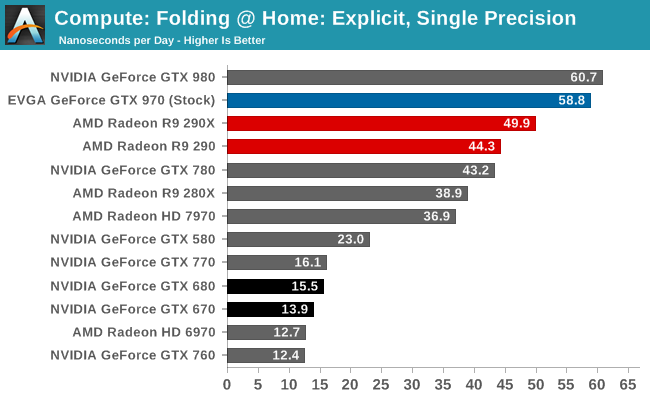
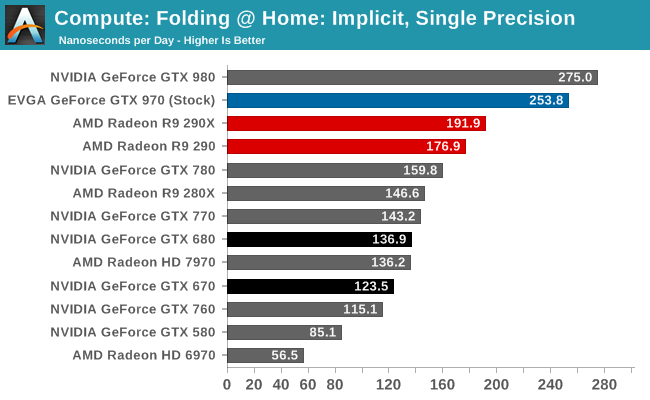
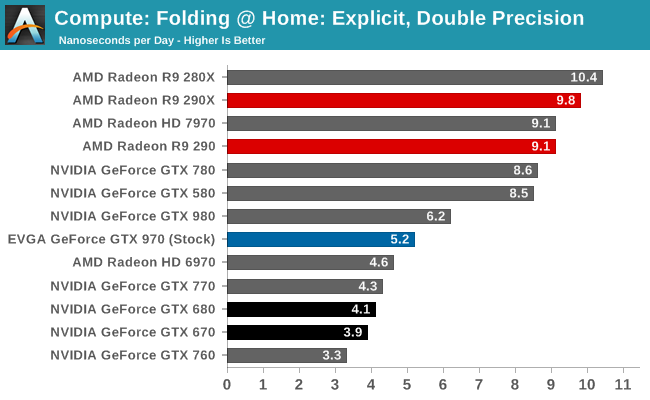
With the GTX 980 holding such a commanding lead here, even with the GTX 970’s lower performance it still is more than enough to easily beat any other card in single precision Folding @ Home workloads. Only in double precision with NVIDIA’s anemic 1:32 ratio does GTX 970 falter.
Wrapping things up, our final compute benchmark is an in-house project developed by our very own Dr. Ian Cutress. SystemCompute is our first C++ AMP benchmark, utilizing Microsoft’s simple C++ extensions to allow the easy use of GPU computing in C++ programs. SystemCompute in turn is a collection of benchmarks for several different fundamental compute algorithms, with the final score represented in points. DirectCompute is the compute backend for C++ AMP on Windows, so this forms our other DirectCompute test.

Recently this has been a stronger benchmark for AMD cards than NVIDIA cards, and consequently GTX 970 doesn’t enjoy quite the lead it sees elsewhere. Though not too far behind R9 280X and even R9 290, like GTX 980 it can’t crunch numbers quite fast enough to keep up with R9 290XU.










155 Comments
View All Comments
AnnonymousCoward - Sunday, September 28, 2014 - link
So you're saying it doesn't matter to say "clocked at 7GHz" when the actual clock is 1.75GHz. Well it matters to me! What if the chip multiplies the core clock by 2 internally; should we then say the core clock is 2.2GHz instead of 1.1GHz?Black Obsidian - Monday, September 29, 2014 - link
And thus the reporting of EFFECTIVE clock speeds. Not everyone does (or can) understand the complexities of the underlying architecture.jtrdfw - Wednesday, September 30, 2015 - link
yes. heatsinks on memory are pretty much a scamMagickMan - Friday, September 26, 2014 - link
How about a 970 OC vs 290 OC comparison? I don't have a favored GPU, I just care about bang for buck.The_Assimilator - Friday, September 26, 2014 - link
What would be the point? 970 already equals or beats 290X, and you don't get much from overclocking Hawaii GPUs, apart from more heat.poohbear - Friday, September 26, 2014 - link
Thank u for including a full stable of previous gen video cards to compare it to! In particularly the 670 & 770! Gives us a better idea of how it performs!Tetracycloide - Friday, September 26, 2014 - link
Seconded. Still running a 6950 flashed to 6970 so having the stock 6970 as a point of reference made this the easiest buy ever. Roughly twice the performance with lower power, heat, and noise? Yes.roxamis - Monday, September 29, 2014 - link
I have the same card (Sapphire 6950 Dirt 3, unlocked to 6970) and one fan of the 2 died last week (hitting 90-100 deg C in games). So with that I went to see what i can replace it with and the 970 ticks all my marks.krazyfrog - Friday, September 26, 2014 - link
The price-to-performance ratio is strong with this one.Frenetic Pony - Friday, September 26, 2014 - link
Certainly, but considering AMD has implemented some of the same things I'd expect an equivalent price to performance ratio from AMD for their new cards. Cut down the 290's bus to 256bit, clock the ram to 7ghz, and with the bandwidth compression you'd get a cheaper card with the same performance.Still, nice all around to have choices, been looking at cards myself, and am going to build a system for my brother quite soon. Yay price wars!